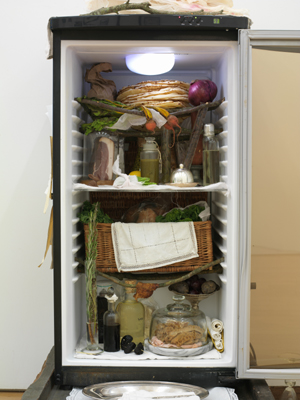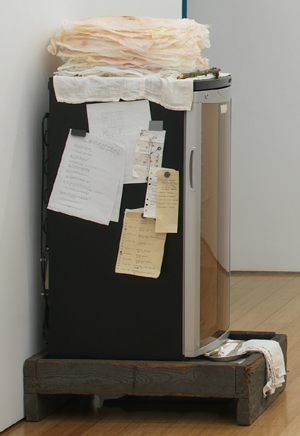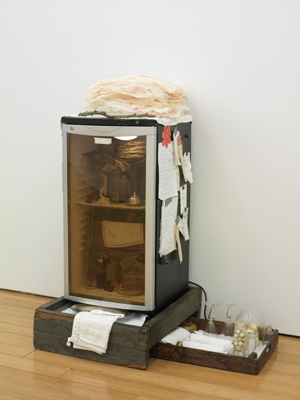This is an archive of the ArtCat Zine, 2007-2009. Please visit our new project, IDIOM.
Mildred's Lane at Alexander Gray

Mildred's Lane
18 June - 6 September 2008
Alexander Gray Associates - 526 West 26 Street #1019
Most refrigerators are dumps. Leftovers from a midnight binge spoil in the back. That overpriced entrée you didn't really enjoy but couldn't bear to throw away because you squandered so much on it lingers. Isn't it ironic how most fridges end up collecting old food that we would rather not eat?
Then, there is cleaning out the refrigerator…. Few tasks could be more Sisyphean.
J. Morgan Puett claims the refrigerator as a site of subtle beauty from within these decadent, first-world horrors of the the 21st century. She honed her ability to find the art within a refrigerator during her stint as the ringleader of the Mildred's Lane art colony in rural Pennsylvania. That colony's output is the subject of Alexander Gray's summer group show, where one can find one of Morgan's fascinating fridges on view.
The refrigerator plays a crucial role at the colony by storing food for communal meals. Lively and outrageous dinner parties in Puett's home are the glue that bonds these artists together. Heated debates ignite, burning wit is stoked, and robust ideas emerge from the conversation's flames like brazen salamanders. Food and drink are perhaps the greatest unifiers amongst artists accustomed to the solitude of creation. As Thomas Cole, another colonist remarked to your commentator about these parties, "the wine flows and everyone gets cozy."
J. Morgan Puett takes great care to arrange the food items in her fridge as they await consumption. The cooler on view at the gallery is no exception. She lines its shelves with white linen and stores items in strange and fascinating vessels. As one peers through the transparent door, one almost feels as though he or she is gazing upon some Dutch still life.
There is actually a hidden code behind the refrigerator's contents on display in the gallery. Puett derived the names of the foods within by rearranging and subtracting letters from the names of the show's artists. This game of scrabble and some sketches of the winning combinations form a diagram on the right side of the fridge. The other side displays a shopping list and an itinerary through the city to procure the resulting foods. Like an art historian decoding the obscure attributes of forgotten saints, one feels the joy of code breaking by matching artist with his or her corresponding food on the list.
It would be the birthright of the French to compile an essay collection on the narratives that frame representations of food in art and literature. In her essay, Nature Vivant, Nature Morte: la représentation de la nourriture (Living Nature, Dead Nature: The Representation of Food) Margueritte Neuveux charts three families of meaning for food depictions.

The first is the voluptuous life. An ample and abundant supply of food is one of the most essential signifiers of wealth and prosperity. In this context, it is significant that the still life genre emerged during the late sixteenth century, at a moment when the emerging class of capitalist merchants set new premises for the visual arts in domestic space. Their motives were complex but it suffices to remember that their power flowed not from heaven's blessing or blue blood but from the nascent system of capitalist production. A still life proclaimed their membership among the winners by showing, "I am rich enough to 'waste' food on the production of art." Such scripts of wealth still underwrite most representations of food in art. That shopping list on the left side demands trips to Chelsea Market rather than C-Town.
The second layer of meaning is the aesthetic game of arranging food. Those competing textures, colors, shapes, and lines of different items create stunning patterns. Puett is well aware of the subtleties of juxtaposing foods for visual entertainment. In the cooler's upper cabinet, strong horizontal planes of vegetables/bread loom like a roof over the contents below. This organic framing device is just one example of the nuanced attention the artist pays to form.
The destiny of decay is the final chord of symbolism. All food is dead on some level - whether it is uprooted vegetables or slaughtered meat. The artificially cool air delays but can never fully prevent this natural process. The slow entropic transition from tempting abundance to festering spoils is now on display in Puett's work.

Why do the terminally ill often cherish life so much more than the rest of us? The inevitability of death inspires many to finally stop and smell the roses. Such tension between impending doom and savoring the smaller pleasures empowers the genre of the still life as each competing polarity reinforces the others potency. Gazing at the contents of Puett's work, the viewer is aware that this delicious splendor is only available for a very short time before nature intervenes. Now is the time to seize and savor the moment before it vanishes.
However, as the fridge stands to remain in the gallery for the course of the summer, its meaning will shift away from such rosy notes of Carpe Diem. In time, the refrigerator will become a wasteland of excess like the ones we know from home. This potential for a scrumptious affair will eventually be squandered as the greens wilt, the meat spoils and the mold coalesces. This narrative of the lost opportunity can strike a deep chord; making the viewer desperate to recover the original moment when the food (and opportunity) was fresh. There is a marvelous dialectic between the fridge as a site of well arranged beauty and potential and the fridge as a wasteland of capitalist squalor.
Via the modern idiom of the refrigerator this work triggers the deep and dark tensions of the still life no longer viscerally felt before the old masters. The British term "Still Life" obscures the gloomier connotations that reside within the term "Dead Nature," preferred by the French and Italians. Still life was once the lowest genre among the emerging capitalists. If viewers likewise find themselves unimpressed, it may be that making the paradoxes of a decadent life so explicit still hits a little too close to home.
ZINE
HOME
TIPS / COMMENTS
CATEGORIES
CONTRIBUTORS
- Greg Afinogenov
- B. Blagojevic
- Adda Birnir
- Susannah Edelbaum
- Julie Fishkin
- Paddy Johnson
- Jessica Loudis
- Christopher Reiger
- Andrew Robinson
- Peter J. Russo
- Blythe Sheldon
- S.C.Squibb
- Hrag Vartanian
